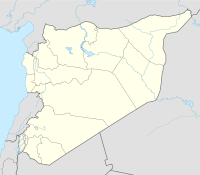الكوم | |
| Location | Homs Governorate, Syria |
|---|---|
| Coordinates | 35°09′00″N 38°49′00″E / 35.15°N 38.81667°E |
| Type | Cluster of tells |
| Area | El Kowm I = 3 hectares (7.4 acres) |
| History | |
| Material | Flint, Bone |
| Founded | c. 7000 BC |
| Abandoned | c. 6500 BC |
| Periods | Paleolithic, PPNB, Neolithic |
| Cultures | Oldowan, Yabrudian, Hummalian, Mousterian |
| Site notes | |
| Excavation dates | 1967, 1978–1987, 1997– |
| Archaeologists | W.M. van Loon, R.H. Dornermann, D. Stordeur, J. Cauvin, M.C. Cauvin, L. Copeland, F.Hours, Jean Marie Le Tensorer, S. Muhesen |
| Condition | Ruins |
| Management | Directorate-General of Antiquities and Museums |
| Public access | Yes |
El Kowm or Al Kawm is a circular, 20 km (12 mi) gap in the Syrian mountains that houses a series of archaeological sites. The El Kowm oasis is located northeast of Palmyra in Syria, near Al-Sukhnah. It shows some of the longest and most important cultural sequences in the Middle East,[1] with periods of occupation by humans for over 1 million years.[2][3]
- ^ Le paléolithique d'El Kowm (Syrie): rapport 1995 - Abstract in English
- ^ Th. Hauck, R. Jagher, H. Le Tensorer, D. Richter, D. Wojtczak 2006: Research on the Paleolithic of the El Kowm area (Syria) Archived 2011-07-07 at the Wayback Machine. Abstract.
- ^ Jean-Marie Le Tensorer, Inge Diethelm, Swiss National Fund for Scientific Research, The University of Basel - Departement of Prehistory Archaeological Mission, Damascus University - Département of Prehistory Archaeological Mission., Le paléolithique d'El Kowm (Syrie): rapport 1995, 130 pages, 1995.
